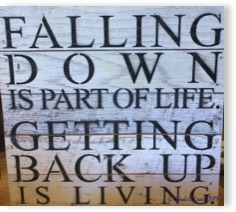Bridging Lives Notes: March 2019
How do you lead here?
Managing with Pain in Mind
Lets say you're in a new position. Let's say you were so successful in your prior position that you've been promoted to take on new challenges that lie well outside your zone of competence. Let's say this time none of what you counted on externally for support is present anymore. And the expertise that you thought made you an exemplary leader where you were does not help you here. You see you've been asked to "lead" in a domain where it seems everyone you're leading now has more specific technical knowledge or domain expertise in that area than you do. You're in new territory without a map and precious little buffer zone for error.
Does this feel familiar to you in some way? Maybe it's your own experience or that of someone you lead. Maybe you can see it coming because it's relatively common in your organizational culture.
How do you lead here?
Pretty consistently, my clients are at some point facing into some version of this real-life gauntlet. They want to give the new challenge/opportunity their best so that they, their teams, and their ventures succeed. The "stretch" feels very real and may even shake the foundations of who they think they are and can be as leaders.
Even for the highest performers, coupled with a courage to learn and to take risks is also a learned "shape" of bravado and fear of failure. Where can they be candid and open about problems, fears, feelings about navigating a situation the constantly outpaces their capacity to control it? We can easily and quickly be caught up in defensive patterns, including the need to be right or "perfect," rather than surrender to what's here to be learned. The "stretch" may challenge their sense of self-worth and call into question whether going for it is even worth it.
When this is happening for you, it can give new meaning to "leaders go first" in creating risk-friendly, learning environments.
Lets say you're in a new position. Let's say you were so successful in your prior position that you've been promoted to take on new challenges that lie well outside your zone of competence. Let's say this time none of what you counted on externally for support is present anymore. And the expertise that you thought made you an exemplary leader where you were does not help you here. You see you've been asked to "lead" in a domain where it seems everyone you're leading now has more specific technical knowledge or domain expertise in that area than you do. You're in new territory without a map and precious little buffer zone for error.
Does this feel familiar to you in some way? Maybe it's your own experience or that of someone you lead. Maybe you can see it coming because it's relatively common in your organizational culture.
How do you lead here?
Pretty consistently, my clients are at some point facing into some version of this real-life gauntlet. They want to give the new challenge/opportunity their best so that they, their teams, and their ventures succeed. The "stretch" feels very real and may even shake the foundations of who they think they are and can be as leaders.
Even for the highest performers, coupled with a courage to learn and to take risks is also a learned "shape" of bravado and fear of failure. Where can they be candid and open about problems, fears, feelings about navigating a situation the constantly outpaces their capacity to control it? We can easily and quickly be caught up in defensive patterns, including the need to be right or "perfect," rather than surrender to what's here to be learned. The "stretch" may challenge their sense of self-worth and call into question whether going for it is even worth it.
When this is happening for you, it can give new meaning to "leaders go first" in creating risk-friendly, learning environments.
Freedom to Explore and Fail
As motivated as you may be to go beyond your comfort zone and be in the learning zone, you still have to attend to real human needs that arise in the face of perceived threat. You may need to start with questions about psychological safety - your own or that of those around you. What can make you - or someone you lead - more willing and able to face into a perceived threat and take the steps needed to learn, maybe fail, and ultimately succeed?
Ask yourself: "what's likely to happen to me if I make a mistake?"
As a leader or manager, your mistakes may be more visible and have bigger consequences. Depending on the mistake,
These can be painful questions. Managing this well or poorly has real costs.
Where you are…
As motivated as you may be to go beyond your comfort zone and be in the learning zone, you still have to attend to real human needs that arise in the face of perceived threat. You may need to start with questions about psychological safety - your own or that of those around you. What can make you - or someone you lead - more willing and able to face into a perceived threat and take the steps needed to learn, maybe fail, and ultimately succeed?
Ask yourself: "what's likely to happen to me if I make a mistake?"
As a leader or manager, your mistakes may be more visible and have bigger consequences. Depending on the mistake,
- How might you be punished or shamed?
- Who will or won't have your back?
- What happens if you look weak or incompetent?
- What kinds of messes will you have to clean up and where?
- Will damage be limited to you or will there be collateral damage to your team and elsewhere?
- What will it take for you to recover, restore broken trust (trust in self, trust in the other person(s), trust in the situation), and move forward again with energy and congruence?
These can be painful questions. Managing this well or poorly has real costs.
Where you are…
- How do you leverage perceived or actual failure?
- How do you make it ok to learn something utterly new and lead there?
That darned threat response!
We know from neuroscience - and from our own lived experience - that "social threats" can register as acutely as physical pain. Think hammer landing on your toe; real pain. Significantly, the social threat pain can have longer-term impact than social rewards.
The threat response is both mentally taxing and can kill productivity - in individuals and organizations. Nobody is immune to natural human threat responses; we learn to manage them, starting with self awareness.
The social brain is "wired" to respond to danger that threatens its core concerns before it can perform other functions - like thinking creatively, learning and adapting to what's new, working well with others, making informed and sound decisions, or taking skillful action congruent with our commitments.
Quoting from David Rock's article, "Managing with the Brain in Mind" …
"If you are a leader, every action you take and every decision you make either supports or undermines the perceived levels of Status, Certainty, Autonomy, Relatedness, and Fairness in your enterprise. In fact, this is why leading is so difficult. Your every word and glance is freighted with social meaning. Your sentences and gestures are noticed and interpreted, magnified and combed for meanings you may never have intended. … Leaders themselves are not immune to the SCARF dynamic; like everyone else, they react when they feel their Status, Certainty, Autonomy, Relatedness, and Fair treatment threatened. … A self-aware leader modulates his or her behavior to alleviate organizational stress and creates an environment in which motivation and creativity can flourish." (link: article by David Rock)
We know from neuroscience - and from our own lived experience - that "social threats" can register as acutely as physical pain. Think hammer landing on your toe; real pain. Significantly, the social threat pain can have longer-term impact than social rewards.
The threat response is both mentally taxing and can kill productivity - in individuals and organizations. Nobody is immune to natural human threat responses; we learn to manage them, starting with self awareness.
The social brain is "wired" to respond to danger that threatens its core concerns before it can perform other functions - like thinking creatively, learning and adapting to what's new, working well with others, making informed and sound decisions, or taking skillful action congruent with our commitments.
Quoting from David Rock's article, "Managing with the Brain in Mind" …
"If you are a leader, every action you take and every decision you make either supports or undermines the perceived levels of Status, Certainty, Autonomy, Relatedness, and Fairness in your enterprise. In fact, this is why leading is so difficult. Your every word and glance is freighted with social meaning. Your sentences and gestures are noticed and interpreted, magnified and combed for meanings you may never have intended. … Leaders themselves are not immune to the SCARF dynamic; like everyone else, they react when they feel their Status, Certainty, Autonomy, Relatedness, and Fair treatment threatened. … A self-aware leader modulates his or her behavior to alleviate organizational stress and creates an environment in which motivation and creativity can flourish." (link: article by David Rock)
Forgiving for the Better
Another aspect to facing into the fear of failure is practicing forgiveness. Forgiving self and other is a necessary step in healing from betrayed trust. Especially where we feel we've been set up to fail, healing from betrayed trust can be a core theme in moving forward as our "better self."
As Elisha Goldstein writes, "forgiveness is the quickest shortcut to beginning again and refocusing on what matters. This doesn't mean we let ourselves off the hook; we learn from it and release the burden so we can begin to be of service to ourselves and others. … Forgive yourself for not knowing what you didn't know before you learned it." (link: article by Elisha Goldstein)
We tend to be at our best when we feel free to explore, fail, forgive and continue learning.
Here are some options you might try where you lead:
We are all works in progress. All the time. Remember: you've got this.
Another aspect to facing into the fear of failure is practicing forgiveness. Forgiving self and other is a necessary step in healing from betrayed trust. Especially where we feel we've been set up to fail, healing from betrayed trust can be a core theme in moving forward as our "better self."
As Elisha Goldstein writes, "forgiveness is the quickest shortcut to beginning again and refocusing on what matters. This doesn't mean we let ourselves off the hook; we learn from it and release the burden so we can begin to be of service to ourselves and others. … Forgive yourself for not knowing what you didn't know before you learned it." (link: article by Elisha Goldstein)
We tend to be at our best when we feel free to explore, fail, forgive and continue learning.
Here are some options you might try where you lead:
- Stay centered in what matters most to you
- Model sincere curiosity - in word and deed
- Frame your work as a learning challenge rather than an execution problem
- Cultivate allies and allyship
- Practice courage by connecting with vulnerability - yours first (link: video by Brené Brown) and by being powerfully uplifting, civil and respectful (link: TED Talk by Christine Porath)
We are all works in progress. All the time. Remember: you've got this.
You are the Bridge to "Better"
I'll be delighted to hear from you in response to the notes offered here.
We can work together from anywhere – whether as an individual or in a group. You are, of course, welcome to meet me in Santa Fe, NM, but the distance between us is easily bridged from wherever you are. Reach out and let’s explore what’s possible together.
For the work that's yours to do, you are the bridge to "better." Thank you for the important work you do and the leader you're becoming while you do it. I'm here as your ally, partnering with you to thrive.
Be in touch...and stay tuned!
Warmly,
Beata
- Let me know what resonates for you in these notes.
- Ask about ways we can focus on growth for you.
We can work together from anywhere – whether as an individual or in a group. You are, of course, welcome to meet me in Santa Fe, NM, but the distance between us is easily bridged from wherever you are. Reach out and let’s explore what’s possible together.
For the work that's yours to do, you are the bridge to "better." Thank you for the important work you do and the leader you're becoming while you do it. I'm here as your ally, partnering with you to thrive.
Be in touch...and stay tuned!
Warmly,
Beata
Lead. Collaborate. Grow. ...to Thrive!









